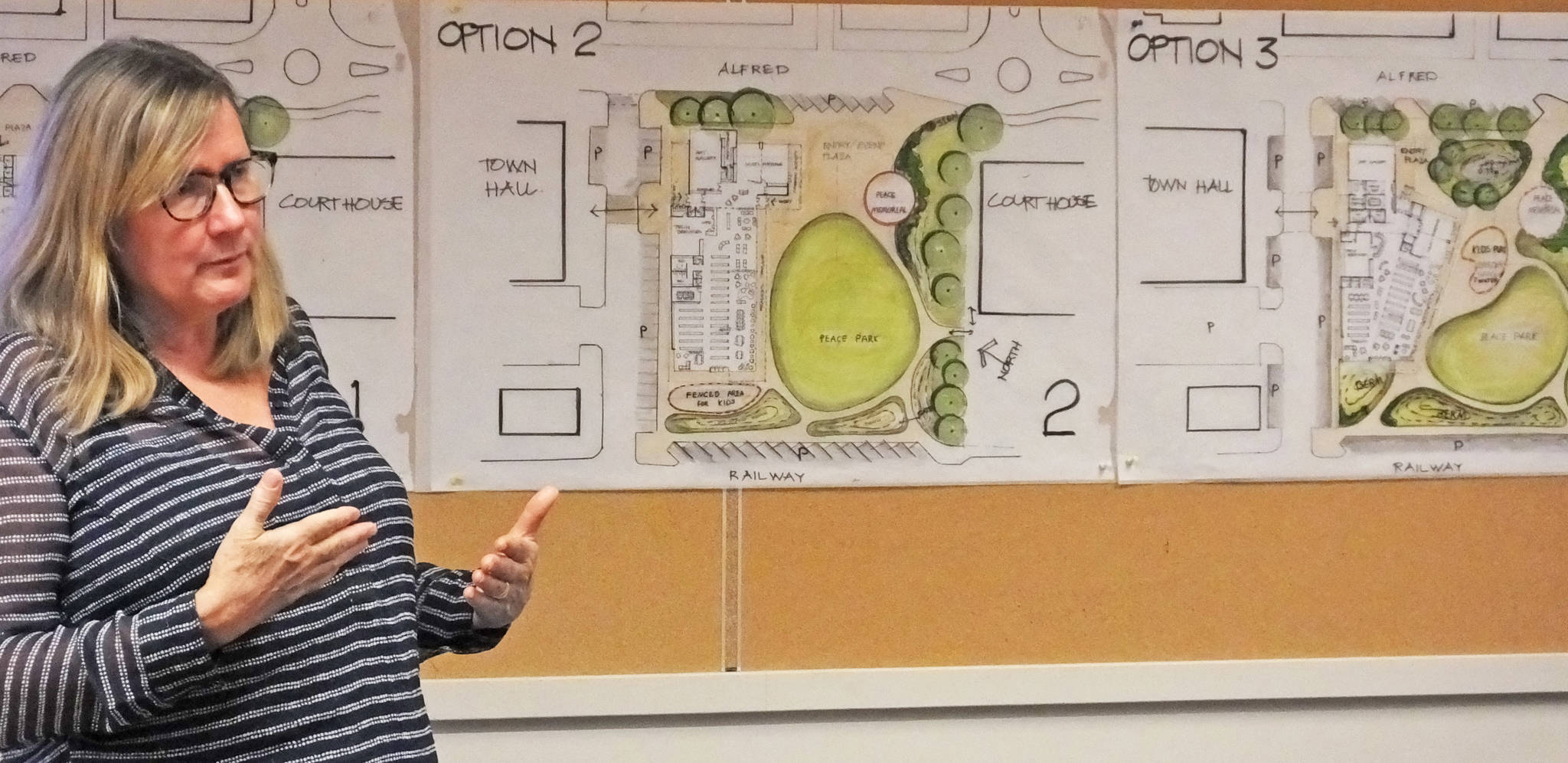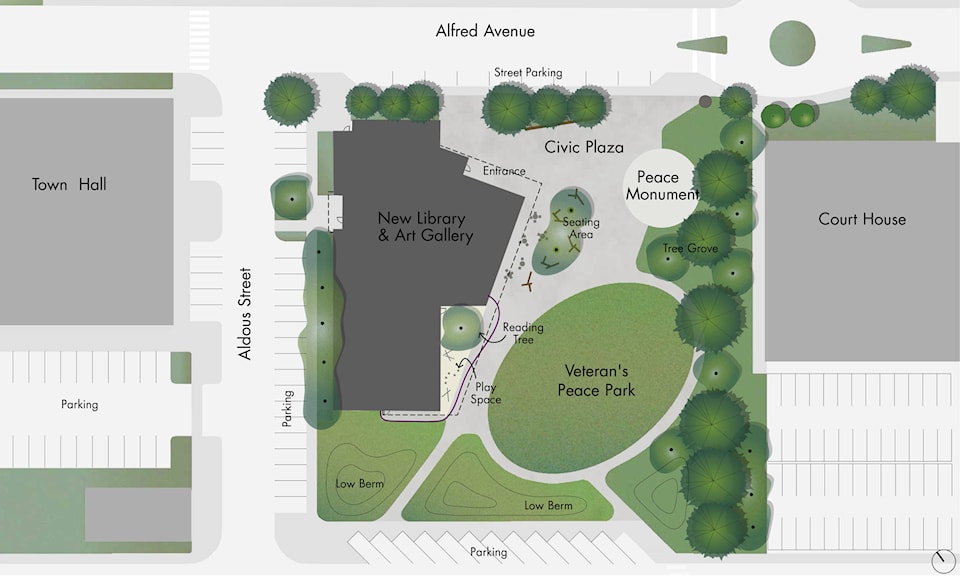Jennifer Marshall of the Space 2 Place Landscape team from Urban Arts Architecture came straight from the airport last Tuesday evening to give the latest on a concept plan for a new library and art gallery building.
The general plan is all drawn up, but with a higher estimated price tag of $15.872 million. The jump from the $10-million suggested budget by council in the five-year financial plan is mostly from estimated construction cost inflation, which consultants hired by the architect pegged at a whopping $3.488 million, or 15-20 per cent per year.
Council did not like those numbers, and asked Marshall and Town staff to look at it again.
A council of the whole meeting was held Oct. 3 to discuss the estimated budget and plan before next Tuesday’s last council meeting ahead of the municipal election. With councillors Bill Goodacre and Phil Brienesse unable to attend, council unanimously passed motions to send recommendations to themselves for the Oct. 9 council meeting to approve the concept design and business case with its $15.872-million price tag, plus have staff proceed with a $1.587-million borrowing bylaw to pay the Town’s share if it gets the grant it wants.
This all, of course, depends on the next council wanting to go ahead with the project and the borrowing getting passed in either a town-wide referendum or alternative approval process.
What would it look like?
As for what the library/art gallery would look like, Marshall gave a detailed presentation, despite stressing it was still in the concept stage and some details could change.
The building was to be 12,000 square feet, but has added about 1,500 square feet of space with the possible addition of a Smithers Exploration Group (SEG) mineral collection area. SEG has not officially signed on yet.
The architect used 2009 public feedback from its new library planning back then, plus some public feedback this year with a focused discussion including the stakeholders — namely the library and art gallery boards and staff, but also the local Royal Canadian Legion.
The existing library will stand until the new building is done, since the new one would be closer to Aldous Street. That opens up space to move the cenotaph closer to the end of Main Street after the old library is demolished, something Marshall said the Legion would appreciate.
“It also may involve a re-imaging of what the cenotaph can be, but they were very sure they wanted their war memorial or their place of remembrance to be much closer to the bottom of Main Street and to be more in the public eye,” Marshall told council.
Maximizing energy efficiency and getting a great view of Hudson Bay Mountain were considered in the angle of the building.
Part of the extra cost is to have the building at Passive House standards, adding $567, 162 to the initial capital cost. But it is estimated that premium would be paid off through energy savings within 12 years, saving operating costs after that.
An outdoor space, possibly with a reading tree stretching through an overhanging roof, would encourage more connection with the park.
The main focus for the architect was having shared spaces with the art gallery and library, so a multi-purpose room, shared entrance and movable wall were included. A gift shop may also be put in. The idea would be to have paintings hung in the library as well as within the the gallery.
Berms are suggested for the park, using dirt dug up from the project itself and creating a fun place to roll or slide over grass and snow.
But some on council and the mayor suggested delaying park improvements may save on the sticker price. No decision was made, but Coun. Frank Wray made it clear he was deviating from his usually financially stringent self with a new Rural and Northern Communities infrastructure fund announced in September that goes well above the usual one-third, one-third, one-third cost share between the federal, provincial and municipal governments for infrastructure projects.
“We do not get another chance to go for 90 per cent of funding. We know $15 million, $1.5 if it’s 90 per cent. This council needs to get the ball rolling now,” said Wray during the meeting.
“We can always at design phase change things and cut cost, but we have what I would say is a high-end estimate, and at $1.5 million is something we can probably take out to referendum and say this is going to be the maximum. Don’t forget we also have some fairly solid commitments of a large donation, so that brings down that number.
“If we mess around and try to bring the number down, and then bring it — when I hear we have to get the borrowing bylaw done in order to apply, that doesn’t happen in three months without getting into it.”
The Province is partnering with the federal government to invest up to $95 million toward an initial intake under the Rural and Northern Communities Program.
Towns between 5,000 and 25,000 population can get up to 40 per cent provincial and 50 per cent federal funding (it is 100 per cent for populations under 5,000) for a wide range of eligible infrastructure.
B.C. Minister of Municipal Affairs and Housing Selena Robinson confirmed to The Interior News shortly after the program announcement in mid-September that along with basic water and roads-type infrastructure, a new library/art gallery would be eligible.
“What we’re looking for is communities that have certainly done their due diligence; they can demonstrate the need; they’re working with partners; it’s going to make a real difference in people’s lives. So those are the kinds of things that we look for when making the decision,” said Robinson.
The Minister said rural communities made the case to her that even 10 per cent is a hard number to get to for small towns.
She made the funding program announcement at the recent Union of B.C. Municipalities (UBCM) convention.
“That was met with tremendous glee by many who are here at the UBCM,” she said.
“I think it’s unprecedented — that we recognize that if you’re wanting to have some education facility or deal with a road infrastructure challenge or broadband connectivity, and you’re a small community of 1,200 people, being able to bring in your traditional portion has been really challenging.”
Smithers director of finance Leslie Ford added that there was a problem with the debt servicing estimate of $30,000 for the first year and $36,000 per year after that.
“I’m not sure where they got the number to be honest … It’s not a correct number, it would have to be revised for sure,” she told council.
If the Town were able to get 90 per cent funding from the provincial and federal governments through the new Rural and Northern Communities infrastructure fund, Ford estimated even with the high construction inflation cost putting the cost at $15.872 million that debt servicing on the approximate remaining of $1.5 million that the Town would need to borrow, would put debt servicing at $113,000 per year.
“I am someone who believes this is a community that has worth, and if we don’t believe in ourselves we don’t get things that are valuable. So it doesn’t mean I’m trying to waste money, but we’ve been waiting a long time and we haven’t had a new piece of infrastructure like this for the arts community — I mean the library was built in centennial year … 1967. Our art gallery/museum live in a building that’s … more than 100 years old,” said Coun. Gladys Atrill.
“It’s just time.”
Library-gallery Concept Design _ Business Case - 20 Sept 2018 by The Interior News on Scribd
From 2015: Library staff have big ideas for Smithers cultural centre
From 2017: Library board proposes using old plan for arts & culture centre

